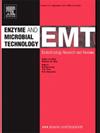The manufacturing of indigo naturalis requires prolonged leaf soaking and lime stirring; the resulting indigo purity is less than 3.00% and the yield of indigo (measured in stems and leaves weight) is less than 0.50%, making it unsuitable for use in industrial procedures like printing and dyeing. An enzymatic method of creating indigo without the requirement for lime was investigated in order to generate high purity indigo. Single factor tests were performed to optimize the enzymatic preparation conditions. The findings showed that 60 °C, pH 5.5, 200 mL of leaves extract containing 0.45 mg/mL indican, and a 4:1 ratio of the acidic cellulose (activity: 9000 U/mL, liquid) to indican were the ideal parameters for enzymatic preparation. The yield of indigo was 40.32%, and the contents of indigo and indirubin were 37.37% and 2.30%, respectively. MALDI-TOF-MS in positive ion mode and UPLC-Q-TOF-MS in both positive and negative ion modes were used to analyze indigo extracts from Baphicacanthus cusia(Nees) Bremek by enzymatic preparation. It has been discovered that 13 alkaloids, 5 organic acids, 3 terpenoids, 3 steroids, 2 flavones, and 7 other compounds are present in indigo extracts. The presence of the indigo, indirubin, isorhamnetin, tryptanthrin, indigodole B, and indigodole C determined by UPLC-Q-TOF-MS was verified by MALDI-TOF-MS analysis. The enzymatic preparation of indigo extracts kept the same chemical makeup as conventional indigo naturalis. Thermal analysis and SEM morphology were used to confirm that there was no lime in the indigo extract. During the enzymatic process, Baphicacanthus cusia (Nees) Bremek was employed more effectively, increasing the yield and purity of indigo.

| 公司名称 | 产品信息 | 采购帮参考价格 | |
|---|---|---|---|
| 上海源叶 | indirubin |
>97.0%
|
¥60.00~¥33858.00 |
| 上海源叶 | indigo |
>98.0%
|
¥19.00~¥7121.00 |
| 上海源叶 | cellulase (RS-1) |
|
|
| 上海源叶 | cellulase (RS-1) |
|


